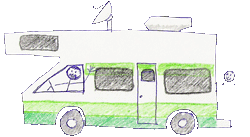Bryce Canyon National Park, Utah




Anyway, we drove SW for 2 ½ hrs to Bruce Canyon NP. Our destination was Sunset CG in the park for one of the first come first served sites. We were lead to believe that North CG was all on reservations, but when we got there we found that only some of the sites were reserved. We had our pick of sites since we were in the CG before noon. We do enjoy being in park CGs because the sites are spread out, in the trees, and close to hiking trails and sites. True, no hookups; but tables, fire pits, showers, and heated bathrooms (important at 8,000 ft).
That brings up the weather. It snowed everyday, and the temperatures ranged from the 20’s to the 40’s. We loved the snow but after about 3 days we were ready for a little warmer weather.
Yes, John has figured out how to survive in the cold weather and not burst our water pipes. The snow also created a problem for the solar panels, as you can see in photo 2.
It made for interesting hiking into the canyon and along the rim of the canyon.
The crowds did not materialize in the CG (presumably because of the weather) but the lodge was full. We’ve seen more than the usual number of European (mainly German and some French and English) tour groups. We have also observed that half the RVs in the parks are rentals and mainly Europeans.
There is an 18 mi drive along the rim of the canyon, so all the overlooks are easily accessible from the road. There is also a free shuttle that runs through the park and to some of the overlook sites.
We ran into some Gators in the CG and enjoyed sharing meals and conversations with Jim and Pat V of
We were happy to hear about the successful landing of the































